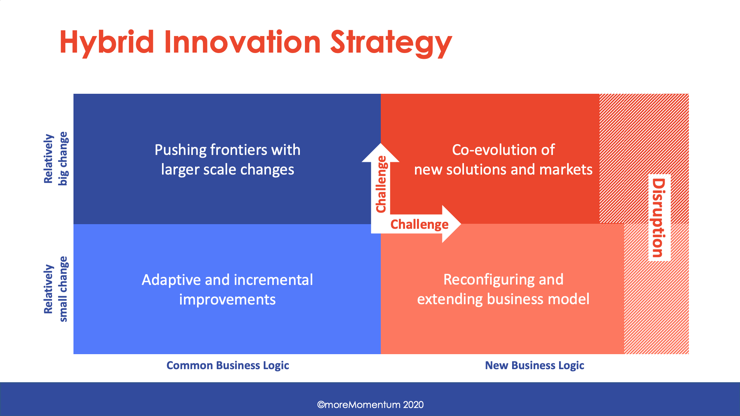Tailoring the Right Innovation Methodology for Each Phase in B2B Services
Navigating innovation in B2B manufacturing is essential for transforming services into strategic business lines. Adopting tailored methodologies for...
6 min read
Jan van Veen
Oct 11, 2023 4:20:34 PM

Navigating New Service Introductions is crucial for transforming your offerings into strategic growth drivers in the digital age. From internal readiness to effective commercialization, mastering these key phases will give you a competitive edge and pave the way for sustainable business success.
In today's fast-paced digital era, service innovation has become a cornerstone for business growth and differentiation. It's no longer just about offering a product; it's about delivering a comprehensive service experience that meets evolving customer needs and stands out in a crowded marketplace. However, the journey from conceptualizing a new service to successfully introducing it to the market is fraught with challenges.
Organizations often grapple with issues such as low adoption rates, negative customer feedback, and operational inefficiencies. These challenges are exacerbated by the scarcity of resources and lack of dedicated teams for service product management. The stakes are high: a poorly executed service introduction can lead to revenue shortfalls, erode stakeholder confidence, and even put the entire business at risk. Surprisingly, this critical phase of service introduction is often overlooked, leading to missed opportunities and increased failure risk.
This article aims to shed light on the often underestimated yet crucial process of New Service Introduction. We will explore actionable strategies to prepare your internal organization for a successful launch and effectively commercialize your new service. By mastering these aspects, you can navigate the complexities of the digital landscape and set your business on a path to sustainable growth.
The introduction phase of any new service is a make-or-break moment that can determine its long-term success or failure. It's where all the planning, development, and strategizing are tested in the real world. A well-executed introduction can set the stage for a service to become a market leader, while a poorly managed one can doom even the most promising service to obscurity.
Two core dimensions are pivotal during this phase: internal readiness and effective commercialization.
Internal Readiness: Before a new service can be introduced to the market, the internal organization must be fully prepared. This involves aligning teams across various departments, from development to sales, to ensure everyone is on the same page. Processes must be refined to handle the new service efficiently, and the right technological infrastructure needs to be in place. Without internal readiness, even the most promising services can falter when they hit the market.
Effective Commercialization: This is the external aspect of introducing a new service. It involves identifying the right market segment, positioning the service effectively against competitors, and setting an appropriate pricing strategy. Equally important is stakeholder engagement, which includes not just customers but also partners, suppliers, and even internal stakeholders like employees and board members.
In summary, the introduction phase is not just a step in the process but a holistic strategy requiring internal and external alignment. Failing to give it the attention it deserves can result in wasted resources, lost opportunities, and business failure.
Read more about Service Innovation in our
Ultimate Guide for Service Innovation
While introducing a new service holds immense potential for business growth, it is fraught with challenges that can derail even the most promising initiatives. Understanding these challenges is the first step toward overcoming them. Here are some of the most common issues organizations face:
In summary, the challenges of New Service Introduction are multifaceted and interconnected. Addressing them requires a comprehensive approach that considers both internal and external factors. Failure to do so can result in missed opportunities, wasted resources, and even the risk of business failure.
Successfully introducing a new service is not just about having a great idea; it's about being internally prepared to bring that idea to life and sustain it in the market. Here are some strategies to ensure your organization is ready:
In summary, internal readiness is not a one-time effort but an ongoing process that requires attention to detail, coordination among various departments, and a commitment to continuous improvement. By focusing on these strategies, organizations can significantly increase their chances of successfully introducing a new service.
Once your organization is internally ready to launch a new service, the next critical step is effective commercialization. This involves a series of strategic actions to ensure that the service reaches its target market and achieves sustainable growth. Here are some key strategies:
In summary, effective commercialization is a multifaceted strategy beyond just launching a service. It involves understanding your market, empowering your teams, setting the right price, and building lasting relationships. By focusing on these areas, you can ensure a successful launch and set the stage for sustainable growth and profitability.
The stakes in New Service Introduction are incredibly high, and the outcomes can be opposites: remarkable success or significant failure. Let's first look at what you stand to gain by mastering this crucial phase.
Positive Outcomes: Successfully introducing a new service can catapult your organization into a new realm of growth and profitability. It can expand your market share, reinforce your competitive positioning, and enhance customer loyalty. Moreover, a successful launch can garner strategic commitment from stakeholders, boost team morale, and solidify your reputation as an industry leader in service innovation.
However, the flip side presents a sobering picture.
Risks of Failure: A poorly executed service introduction can have far-reaching consequences. It can stagnate your service transformation journey and expose you to excessive risks, especially after substantial investments. The ripple effect can damage—losing ground to competitors, missing out on market opportunities, and eroding stakeholder trust. The long-term impact could be a decline in business and a tarnished reputation that takes years to rebuild.
In today's rapidly evolving digital landscape, mastering New Service Introduction is beneficial and essential for sustainable business growth. The challenges are many, but so are the rewards. The key lies in meticulous internal and external planning to ensure a successful launch and long-term viability.
The stakes are high, but the potential for growth and success is even higher. The next steps are yours to take. Utilize the strategies and insights this article shares to effectively navigate the complexities of introducing a new service.

The Service Transformation Summit on Advancing Your Service Innovation Capabilities covered the content of this article and more, such as:
This Summit, which took place on June 5-6, 2024, was a unique opportunity to deepen your understanding of these topics, connect with industry leaders, and engage in enriching discussions about real-world cases of your like-minded peers.
So, if you're passionate about service transformation and are committed to sparking positive change in your organization, we warmly invite you and your service leadership teams to join us at our upcoming Summits.
Let's transform the service industry together.
Subscribe for the our Impulse Letter
With regular updates about service news, trends and best practices.

Navigating innovation in B2B manufacturing is essential for transforming services into strategic business lines. Adopting tailored methodologies for...

A balanced mix of sustaining, adjacent, and transformational innovations is essential for long-term success in B2B manufacturing, but many companies...

Agile Service Product Management is vital to thriving in the digital age. It encompasses the critical role of service product managers in driving...